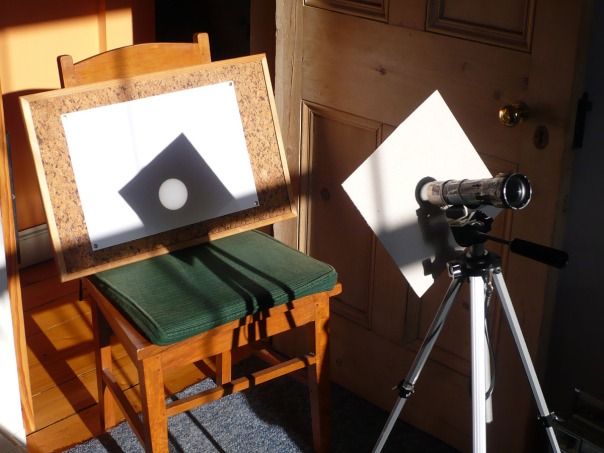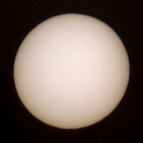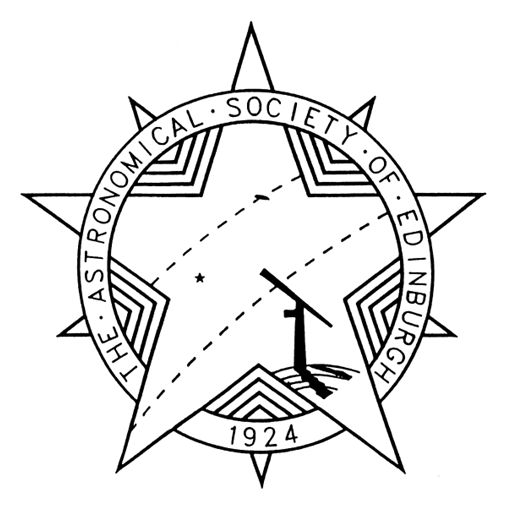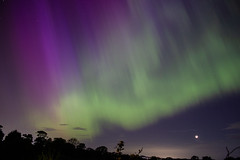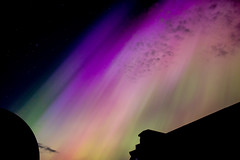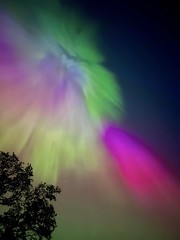Monthly Archives: April 2015
Solar Eclipse 2015 – Members’ Experiences
This has probably been the best solar eclipse that I have observed to date. In August 1999 I made the journey down to Cornwall in anticipation of observing the first total eclipse on mainland Britain since 1927, but I was disappointed in having totality obscured by cloud from where I was observing (in the village of Lamorna near Land’s End). Then in 2006 I was on hand to observe a partial solar eclipse at the City Observatory with several other ASE members, including Ken and Graham. We had good weather for this event, but only about 20% of the sun was covered at maximum eclipse. With this eclipse on the 20th March predicting 94% coverage in Edinburgh, it seemed like a great opportunity to see an eclipse in detail.
Having said that, the weather forecasts had been predicting thick cloud and I was wondering if we would see anything at all! Good omens appeared during the week, though, when we were getting clear skies in the mornings. You have probably noticed this yourself, how often it is clear first thing in Edinburgh but then clouds up later in the day. One of the first things I checked out was whether I would be able to watch the eclipse from the back room of our flat and I was pleased to see that by 8.30am the sun had already cleared the rooftops opposite. It also gave me the opportunity to practise projecting the sun onto paper using a small telescope (see above). You don’t need much to get a decent image and this small scope rigged from the objective of a pair of binoculars sufficed. In fact I got a pretty decent image of the sun on the day before the eclipse (left) in which you can see sunspots on the limbs at the left and far right. I used the macro setting on a small digital camera to photograph the paper.
You can imagine my surprise on the morning of the eclipse when it dawned fair and bright! I got equipment set up and took an image of the sun prior to the eclipse starting. Then it was all go as the moon took the first bite out of the sun at about 8.30am (left). You can see how far the sunspot at the right has moved since the previous day.

Image showing the progress of the eclipse, taken at 10 minute intervals throughout – all photos can be enlarged by clicking on them. (Photo: Duncan Hale-Sutton)
I did manage to get a whole sequence of pictures every 10 minutes or so up until the time of maximum eclipse about an hour later (see above). By then we were experiencing intermittent cloud which enabled me to face out of the window to see that happy smile over the rooftops (see below). After that I was more relaxed and taking pictures less frequently. By the end of last contact it was touch and go whether I would see it as cloud was becoming much thicker, but I did, just.
I would say that, even though I thought I was prepared, I still found I was rushing around like a headless chicken and finding out that I had failed to charge the batteries on some of my other cameras. I had hoped to experience how the light levels change outside but I had my back to the window for most of the time. I also made the classic mistake of not realising that the image I was photographing was a mirror image of how you usually see the sun in pictures (because I was photographing the front of the paper and not the back, so to speak). This meant that, although I had put some pictures up early on the ASE Flickr pages, I had to pull them later and resubmit them so that I could get the sun the right way round.
All in all it was a great experience, but maybe next time I will just go outside and enjoy the whole thing without worrying about recording any of it!
Duncan Hale-Sutton
This is one of a series of personal accounts recorded by our members of their experience viewing the partial solar eclipse on the 20th of March 2015.
Solar Eclipse 2015 – Members’ Experiences

Members of the Society aid members of the public in viewing the eclipse outside the Scottish Parliament. (Photo: Alan Ellis)
I was helping Peter Mulholland, guiding members of the public to his telescope and, from time to time in between viewers, had a look myself at the progress of the moon over the sun. It was very enjoyable helping the public to view the eclipse and saw it myself at various stages. This is the second eclipse I have seen and it was better than the first time – it was fantastic. The atmosphere with so many people there was brilliant. A thoroughly enjoyable morning.
Anne Bulman
This is one of a series of personal accounts recorded by our members of their experience viewing the partial solar eclipse on the 20th of March 2015.
Solar Eclipse 2015 – Members’ Experiences
I would imagine that the majority of our members at least attempted to view the solar eclipse which took place on the 20th of March this year, and everyone will have had a different experience depending on whether they shared the event with the crowds at the Scottish Parliament, or sought cloudless skies to get that prized series of eclipse photos. I asked our members to send me their story of the 2015 eclipse, to capture the variety of settings, purposes, and results we had across the membership for an event which will not be topped in Scotland for a good number of years. These are our stories…
Science and Magic of Light, the Universe and Everything 2015

Chris Lintott starting his talk on ‘Our Colourful and Luminous Universe’ at Science and Magic of Light, the Universe and Everything 2015.
Science and Magic of Light, the Universe and Everything on 28th March 2015 was billed as a warp speed tour of our amazing universe led by world leading scientists and magicians. The day of free talks, demos and discussions took place at Edinburgh University Debating Hall in Bristo Square, and was intended to be suitable for all ages. This is, I believe, the third such day of astronomy talks organised by Astronomer Royal for Scotland, Professor John Brown, Lorna McCalman and Charlie Gleed which the ASE have been involved in, and was a great success in celebrating the International Year of Light 2015.
During the course of the day there were talks by astronomers Prof. John Brown, Prof. Colin McInnes, Prof. Martin Hendry and Prof. Chris Lintott, while magicians Euan Callison, Kevin McMahon and, of course, our Astronomer Royal John Brown injected some magic into the event. The talks were brilliant and the magic engaging. I noted a number of serious astronomers cracking a smile at various points, not least when poor Chris Lintott was attacked by Zurg the naughty Alien!
Alongside the event, there were planetarium shows being run throughout the day by Cosmos Planetarium, Jamie Shepherd had again come along with his impressive collection of meteorites, and the ASE were out in force with a display set up in the foyer outside the Debating Hall. We had the usual information and hand-outs available, as well as a couple of telescopes on show and a number of members available to talk to interested parties. We had a great turn out which meant that there was always someone available to look after the telescopes and display while other members listened in to the various talks, or took the solar telescope outside to attempt some solar observing during breaks in the clouds.
The good turn-out of members not only meant that we were all able to take breaks from engaging with the public to listen in to the talks or go for lunch, but it also meant that we had a great group of like-minded people to discuss the content of the talks with, as well as any other topics which came up. I very much enjoy doing outreach and sharing my love of astronomy with others, but it is always better with friends. Being in the ASE has a lot of benefits, but the friendship with others who share your passion is one of the best things for me, as I know that I will always have a great time when there are other members involved.

ASE members with Prof. Chris Lintott, current president Ken Thomas, and honorary presidents Prof. Andy Lawrence & Prof. John Brown.
Science and Magic of Light the Universe and Everything was a great day of talks, an excellent chance to spend the day with other astronomers from all over the country, and to round it off, the ASE contingent even managed to get a group photo with Chris Lintott!
Rachel Thomas
Rachel has been a member of the Society for over 10 years, and during that time has been actively involved in most of the public outreach events attended or organised by the ASE. She is currently on the Council, Tweets for the Society, and reinvented the Journal into its current online presence in 2013.
Scotland’s Sky in April, 2015
Mercury joins two brightest planets in evening sky

The maps show the sky at midnight BST on the 1st, 23:00 on the 16th and 22:00 on 30th. An arrow depicts the motion of Venus after the middle of the month. (Click on map to englarge)
Spring may have arrived, but the leading constellation of our winter sky, Orion, is still on view in our early evening sky, if not for very much longer. Look for it in the south-west at nightfall, with the three stars of his Belt lying almost parallel to the horizon. Stretch their line to the left to reach Sirius in Canis Major, our brightest nighttime star, and to the right towards Taurus, with its bright star Aldebaran and the Pleiades star cluster. High in the south-south-west is Gemini, with the twins Castor and (slightly brighter) Pollux.
To the south of Gemini is Procyon, the Lesser Dog Star in Canis Minor. Together with the true Dog Star, Sirius, and the distinctive red supergiant Betelgeuse at Orion’s top-left shoulder, Procyon completes an almost-isosceles triangle which we dub “The Winter Triangle”. At present, in fact, it forms a similar but smaller triangle with Pollux and the conspicuous planet Jupiter which dominates our southern sky at nightfall. Leo stands to the left of Jupiter with its leading star, Regulus, in the handle of the Sickle.
As April’s days lengthen, our whole sky-scape shifts further westwards each evening until, by the month’s end, Orion is setting in the west as the sky darkens
The Sun climbs more than 10° northwards during April and sunrise/sunset times for Edinburgh change from 06:44/19:50 BST on the 1st to 05:32/20:49 on the 30th. Meanwhile, the duration of nautical twilight at the start and end of the night stretches from 84 to 105 minutes.
The Moon is full on the 4th when a total lunar eclipse is visible from the Pacific and surrounding areas but not from Europe. In fact, totality, with the moon just inside the northern part of the Earth’s dark umbral shadow lasts for a mere 4 min 34 sec centred at 13:00 BST, making this the briefest total lunar eclipse for 486 years. By comparison, totality lasts for 72 minutes during the next total lunar eclipse which is visible from Scotland on the morning of 28 September this year. The Moon’s last quarter on the 12th is followed by new moon on the 18th and first quarter early on the 26th.
By nightfall on the 26th, that first quarter Moon lies 6° below Jupiter in the south-south-west. Jupiter, itself, dims a little from magnitude -2.3 to -2.1 and is slow-moving in Cancer 5° to the left of the Praesepe cluster in Cancer. The star cluster is best seen through binoculars which also show the changing positions of the four main Jovian moons as they swing from side to side of the planet. The giant planet progresses into the south-west by our star map times and sets in the north-west more than five hours later.
Even though Jupiter is twice as bright as Sirius, it pales by comparison with the evening star Venus which blazes brilliantly in the west at nightfall, and sets at Edinburgh’s west-north-western horizon by 23:38 BST on the 1st and in the north-west as late as 01:08 on the 30th. This month Venus approaches from 180 million to 150 million km and swells in diameter from 14 to 17 arcseconds, its dazzling disk appearing gibbous through a telescope as its phase changes from 78% to 67% illuminated.
Venus also speeds eastwards during the period, moving from Aries to Taurus where it passes 2.7° south of the Pleiades on the 11th to end April 3° south of Elnath at the tip of the Bull’s northern horn. There should be an impressive sight on the evening of the 21st when Venus lies 7° above-right of the earthlit crescent Moon which, in turn, is 2.5° above-left of Aldebaran.
Mars, magnitude 1.4, is low and hard to spot in our western evening twilight, becoming lost from view later in the month as it tracks towards the Sun’s far side. However, after passing beyond the Sun at superior conjunction on the 10th, Mercury emerges in our twilight to begin the innermost planet’s best evening apparition of the year.
On the 19th, Mercury shines at magnitude -1.3 and stands 4° high in the west-north-west forty minutes after sunset. Mars lies 2.8° above and to its left while the sliver of the earthlit Moon is 12° high and to their left. By the month’s end Mercury is 10° high forty minutes after sunset and shines at magnitude -0.4 22° below and to the right of Venus and only 1.7° below-left of the Pleiades. Binoculars may help to pick it out at first but it should emerge as a naked-eye object as the twilight fades and it sinks to the north-western horizon by 23:00.
Saturn is on show during the second half of the night though it does not climb far above our horizon so is not well placed for the sharpest views of its stunning ring system. For Edinburgh, it rises in the south-east at 00:46 on the 1st and by 22:40 on the 30th, reaching its highest point of 15° in the south four hours later before dawn.
Shining at magnitude 0.3 to 0.1, Saturn lies in Scorpius where it creeps 1.5° westwards above the double star Graffias. As it lies below and left of the Moon on the 8th, a telescope shows the planet’s rotation-flattened disk to be 18 arcseconds wide, within rings that span 41 arcseconds and have their northern face tilted Earthwards at 25°. Although they show an amazing complexity on the small scale, the main rings, dubbed A and B, are separated by the relatively empty dark arc of the Cassini Division. B, the brightest of the rings, has A outside it and the dusky C ring within.
Alan Pickup
